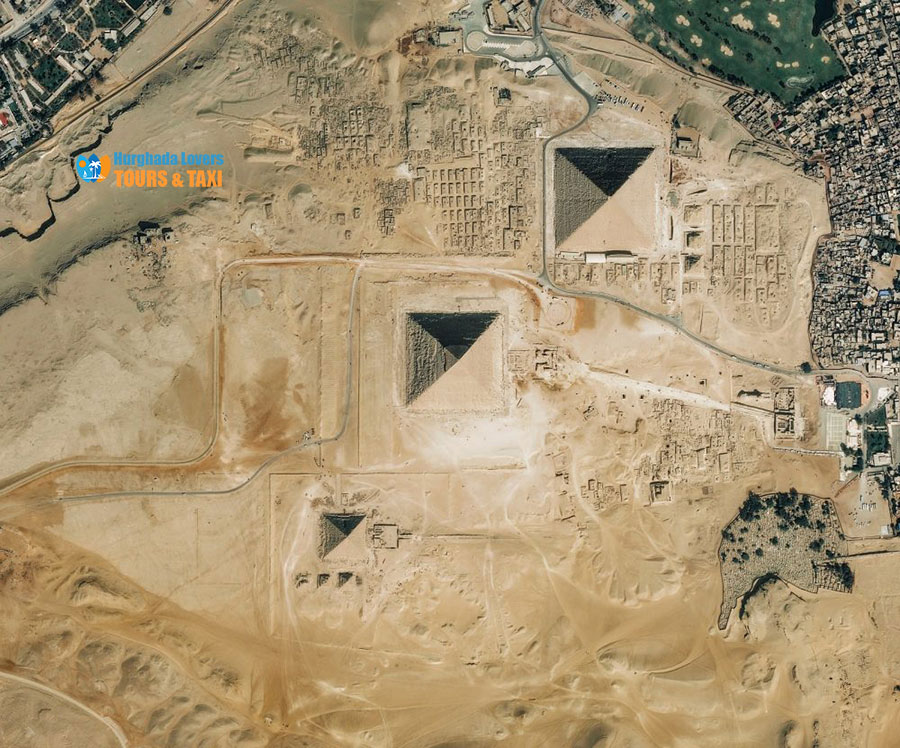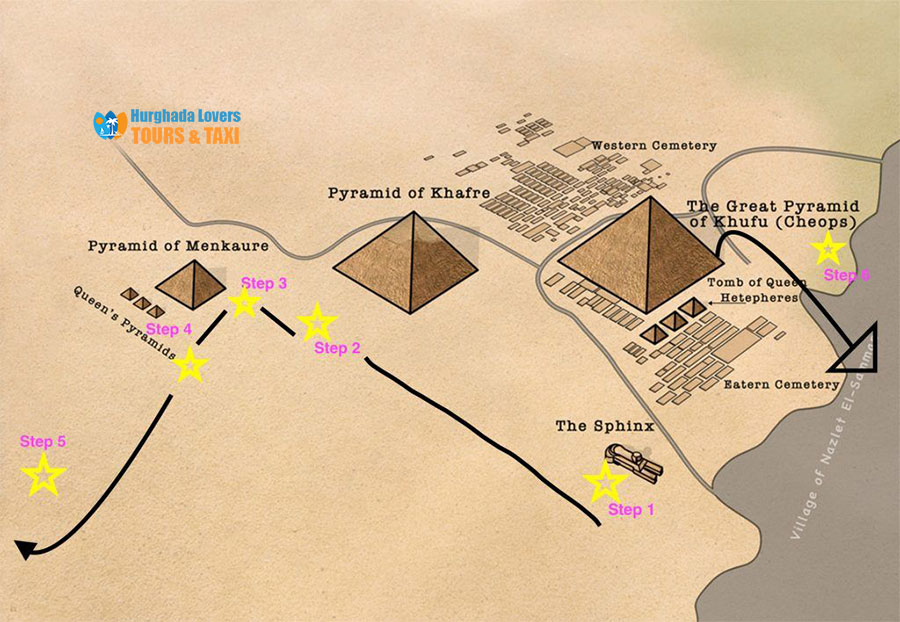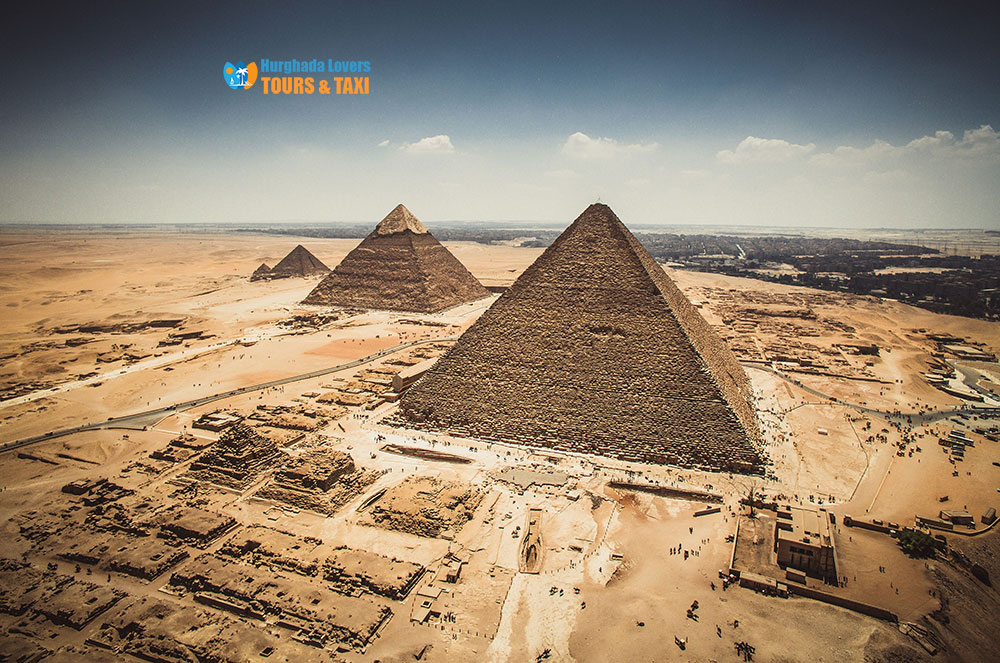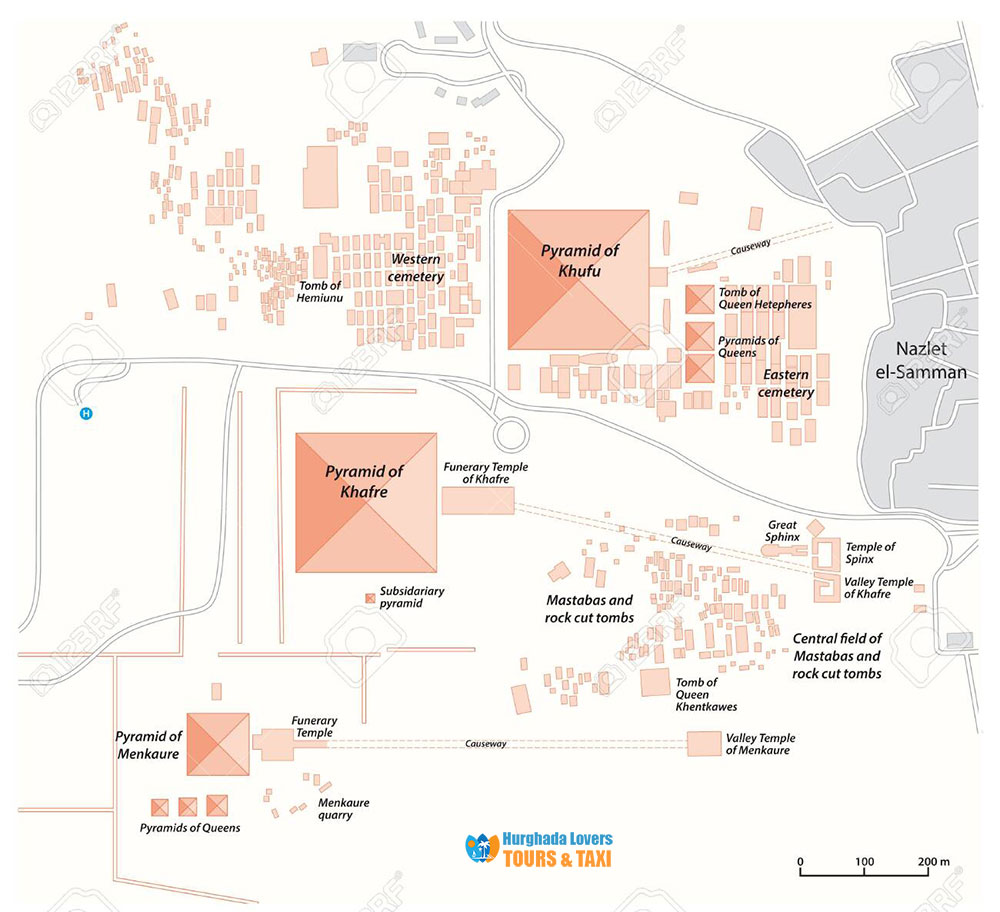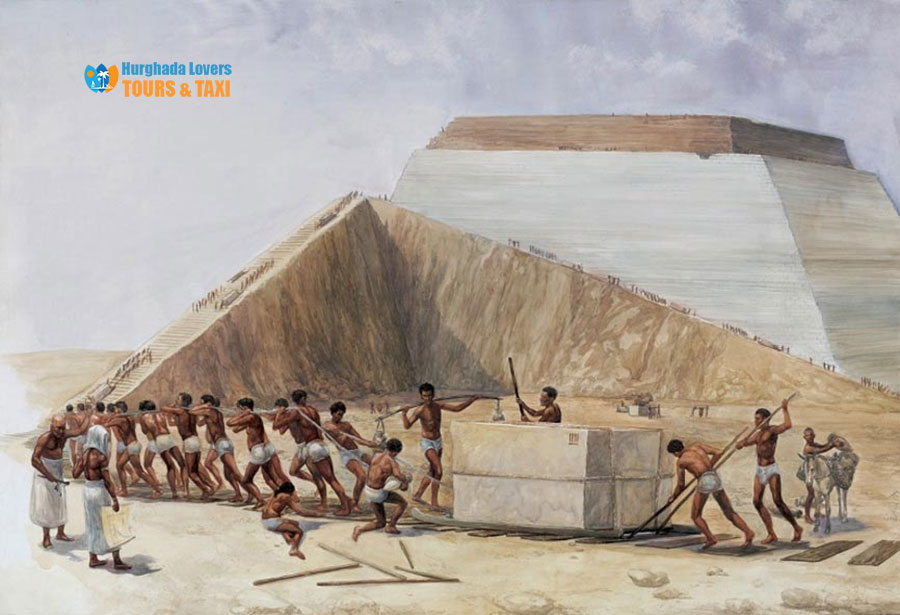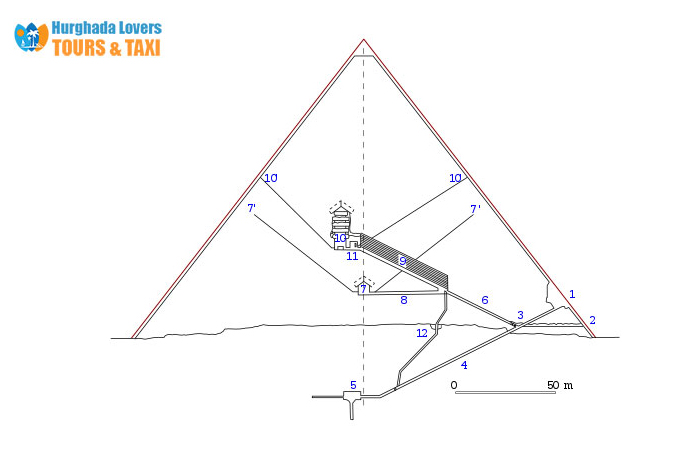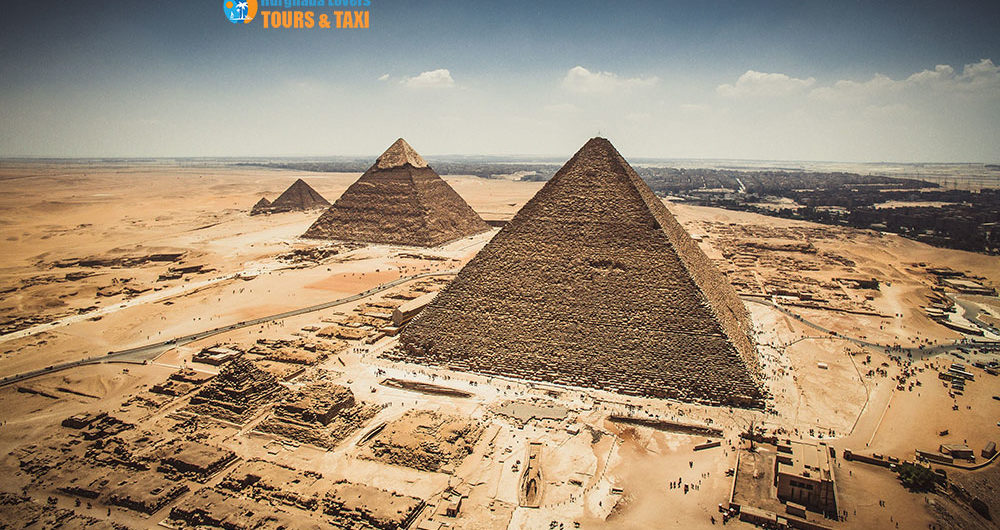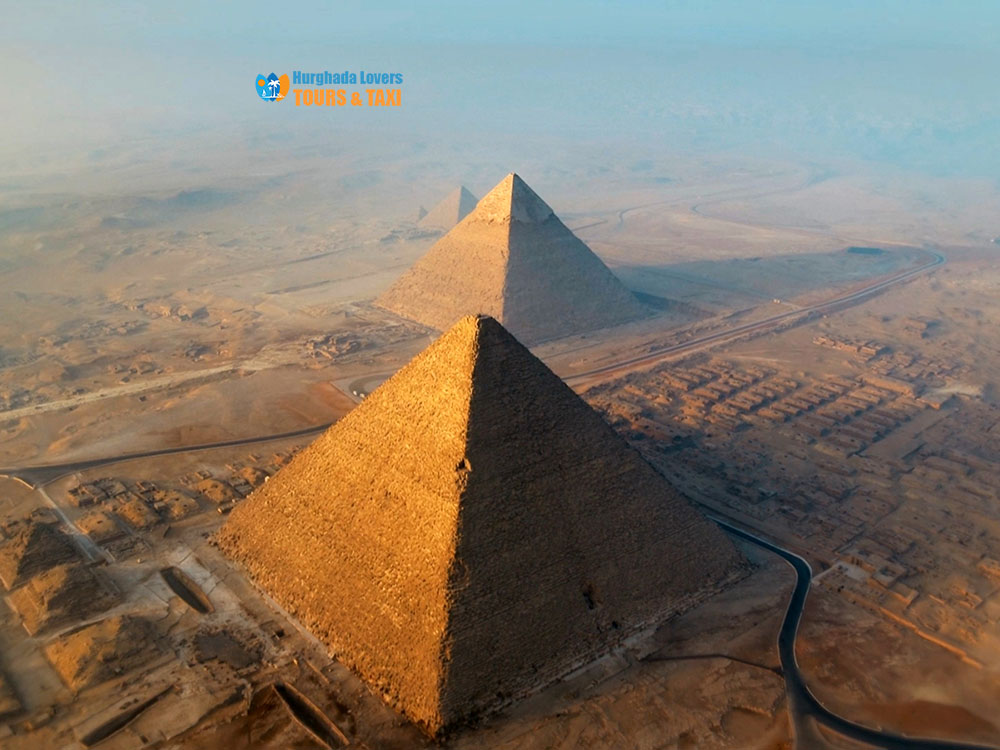Pyramids of Giza Egypt | Facts, History, Secrets of the Construction of the three Egyptian Pyramids.
The pyramids of Giza history and secrets of the construction of the three Egyptian pyramids recognized for building the pyramid of Cheops, Chephren and Mikerinos, information on how the pyramids were built and why the great pyramid was built and designed from the inside, visit dates, entrance ticket prices and more.
The most important attractions of Giza ancient Egypt, the secret of the construction of the Pyramids of Giza of Cheops, Chephren and Mikerinos and more about the culture of the Ancient Egypt.
History Of Egyptian, Information and secrets of the construction of the three Egyptian pyramids the most important tourist places in Cairo Egypt, discover the secrets of the construction of one of the seven wonders of the world and the statue of The Sphinx of Giza in addition to the information you did not know before to start your Cairo Tours to visit the most beautiful Pharaonic archaeological attractions & Things to Do in Egypt.
Hurghada lovers Offer Luxury Hurghada to Pyramids Tours | El Gouna to Pyramids Tours | Makadi bay to Pyramids Tours | Sahl Hasheesh to Pyramids Tours | Soma bay to Pyramids Tours .
Pyramids of Giza Egypt
The first pyramid of the three is the Great Pyramid, known as the Pyramid of King Cheops, one of the seven wonders of the world.
The pyramid of Cheops, the first pyramid, the largest Pyramids of Giza:
Dynasty: 4th
Date of construction: Approximately. 2560–2540 B.C.
Height:
146.5 meters (481 feet) at the time.
138.8 meters (455 feet) currently
Base: 230.4 meters (756 feet)
Architect: Hem Iuno
The pinnacle reached by the development of architecture in the old Kingdom is the Great Pyramid built by Cheops at Giza, built by Minister Hem Iuno, cousin of the king, and by virtue of his work as supervisor of the king’s constructions.
The construction of this pyramid required the use of more than 2 million limestone blocks, some weighing up to 15 tons, extracted from quarries close to the region, and the stones used in the exterior cladding are softer and purer stones. The pyramid of Cheops was built on an area of 12 acres and reached an altitude of 146 meters while the Pyramid of Djoser was 60 meters high.
The geometric design of the pyramidal tomb changed during the reign of King Cheops; the underground burial chamber of the Pyramid of Djoser moved to a room integrated into the body of the pyramid, whose walls and ceiling were covered with huge granit stones, and as the king’s tomb was usually in the middle of the royal cemetery, the Pyramids of Giza are small for members of the royal family, while the mastabas of statesmen are located to the south.
On the east side of the pyramid, Cheops built his funerary temple, but there is only part of the foundations of the walls cleared above the rock, and part of the floor of the temple hall, which is made of basalt stone, and these few remains, although small, have provided archaeologists with enough evidence to try to make a sketch of the eastern part of the temple, which is quite different.
Concerning the funerary temples that were before him or built after him. The entrance to this temple leads to a large columned hall, a rectangle and its long axis from east to west, and the roof of the portico was mounted on granit columns, small pieces of which were found. The western part of this temple could be almost completely vandalized.
Information about the Pyramids of Giza – The Great Pyramid:
- King Cheops built the pyramid around 2650 BC.
- The pyramid of Cheops was erected at the time of the Fourth Dynasty on a plateau of 45 meters above sea level.
- The height of the pyramid is 137 meters at a square base the length on each side of the pyramid 226.5 meters.
- The pyramid of Cheops is about 13 Herewith a corner of about 51.50 degrees.
- The huge stones were used in the construction of the Great Pyramid, with an average weight of stone of 2.5 tons.
- The pyramid consists of 2 million and 300,000 limestone blocks, where the largest pyramid is architecturally characterized in terms of beauty of proportions and coherence of lines.
- It took 20 years to build the Great Pyramid.
- Contributed to the creation of the Great Pyramid 100,000 workers.
- The original entrance to the pyramid is in the middle of the north side at an altitude of 20 meters above the level of the plateau.
- The current corridor of the pyramid of Cheops is the corridor that the Kalife al-Maamoun made in the 9th century AD during his visit to Egypt and explored what lies inside the pyramid.
- The Great Pyramid is the largest tomb and the most famous archaeological building in the world, where the Pyramid of Cheops represents the greatest efforts and experiences of the builders of the Pyramids of Giza.
- It was built as a tomb for King Cheops (Khufu) of the fourth Pharaonic dynasty.
Pyramid of Chephren – Pyramid of Khafre son of King Cheops
Dynasty: 4th
Height: 136.4 meters equivalent to 448 feet was at the beginning of construction: 143.5 meters equivalent to 471 feet.
Base: 215.25 meters equal to 706 feet
Slope: 53°10′′
King Chephren is one of the successors of Cheops, who built his Pyramids of Giza, slightly smaller than his father’s. The Valley Temple of the pyramid of Chephren, designed in the form of the letter T, is one of the most beautiful architectural works of the Old Kingdom.
On the east side of the pyramid is the Temple of Chephren and a complete pyramid group in the Giza Cemetery, revealed by the Von Zahlin Mission under the supervision of Holcher and Shettendorff.
Two secondary columns and a columned hall are almost as wide as the building and between the temple and in the pyramid there is an open courtyard, with forced stone walls covered with granit. Where Chephren’s pyramid is a little less than his father’s.
It was built by King Chephren the fourth king of the Fourth Dynasty, the son of King Cheops. He married Princess Mer Es Ankh.
- The term of King Chephren’s reign was twenty-six years.
- The pyramid of King Chephren is lower than the pyramid of his father (Khufu). It was 143 meters high and now 136 meters high.
- Chephren called his pyramid the great.
- The height of this pyramid when it was built was 143.5 meters, and the length on each side of its square base was 215.5 meters, while its angle is 53.10 degrees, and the stone cladding remained the part near the top.
- The pyramid of Cheops has two entrances in the middle of the northside leading to a long corridor ending in the burial chamber. The visit of this group makes the visitor feel a deep sense of greatness and the visitor can also follow his diagram.
One of the most famous ancient works highlighted by oriental art is a collection of statues of Chephren and the motif of this collection, including the famous statue of Diorithe, which is now a masterpiece of the Egyptian Museum and made of the stone of the hard Diorithe, which was brought from the quarries of Toshki.
The Pyramid of Mikerinos – Pyramid of Menkaure or the pyramid of King Men Kaou Ra:
Dynasty: 4th
Height: 65.5 meters equivalent to 215 feet
Base: 103.4 meters equivalent to 339 feet
The last of the great Pyramids of Giza, which is inferior to the pyramid of Cheops in size, and its funerary annexes seem unfinished, and there are those who believe that the high costs of building the Pyramids of Giza exhausted the resources to build the third pyramid and the construction stopped there.
The Pyramid of the King is located in the southwestern part of the Pyramid of Chephren and a pyramid of the smallest pyramid of the three Pyramids of Giza.
The King’s Pyramid was built on a cliff from the slopes of the plateau and the place was colonized using forced stone blocks.
- Each side is 108.5 meters long.
- The King’s Pyramid is 66.50 degrees high and 51 degrees.
- Its entrance on the north side rises to about four meters above sea level.
The internal planning of the pyramid of Mikerinos is not simple, because the original entrance was discovered by Face in July 1837, during its vain transfer to the burial chamber through the artificial passage and continues with a small descent until it reaches a room that was clearly originally intended to be the burial chamber, where there is evidence that the coffin was placed there, and this room is large.
The king’s coffin is made of basalt and decorated with Egyptian designs such as doors, and this coffin was found without a cover, located inside a burial chamber of some Arabic writings written carelessly on the walls.
- The king died before completing his pyramid, and it was completed it after the death by his son, Shepssesskaf.
- The height of the pyramid of Mikerinos is 65.5 meters, and now 62 meters after the fall of its outer casing.
- A mummy is now kept in the British Museum.
- Mikerinos called his pyramid “sacred.”
- The pyramidal slope angle from 51°20′25″ is 51°20′25.
- The entrance to the pyramid to the north. The entrance rises about 4 meters above the ground, falling 31 meters long. Its slope angle is simple at about 17 degrees.
- A limestone pyramid was built, but Mikerinos chose to build the lower part of it from the granit that was brought from Aswan by the Nile.
- The granit cover is about 17 meters high. The rest of the cover was made with white limestone from Toura up to an altitude of 65 and a half meters.
Theories about how the Pyramids of Giza were built:
The first theory of the mystery of the construction of the Pyramids of Giza:
An important theory about how to build the Pyramids of Giza is that of the ancient historian Diodor the Sicilian, the way bridges or rising ramps are built, and many modern archaeologists believe that this method is the closest way to the mind, including I.E.S Edwards, Dr. Ahmed Fakhri, Somers Clark, R. Engelbach, Dr. Zahi Hawass.
This theory explains the technique of construction, explaining that the ancient Egyptians built a progressive road using gravel mixed with clay, and this ascending bridge had mud brick walls until this mixed gravel was fixed in place, and this road intensifies with the height of the pyramid inclined in the corner to the top of the pyramid itself.
At the same time, this road must be extended in length so that its angle of slope remains the same, and this ascending corridor has been reinforced by wooden veins that reduce friction and noise from wooden moving lists, which are used to transport blocks of stone, and after the construction of the pyramid, they are removing that road.
Interestingly, the ships or models are located near the Pyramids of Giza, which is mainly a religious procedure of other religions, usually referred to as ships found next to the Pyramids of Giza as “solar boats,” but this name is not accurate.
However, the ancient Egyptians had several types of ships intended to provide the deceased king with a material alternative to the ships he needed in other lives.
According to the study of the pyramid texts, there were at least eight types of ships used by the king in his celestial voyages.
That is why only two of these ships can be called solar ships, not for any other purpose. It is therefore preferable to call these ships funerary or liturgical boats, which were undoubtedly closely linked to the religious beliefs of the post-mortem resurrection.
The construction of the Pyramids of Giza spread to the west and south of Egypt; some Pyramids of Giza were found in Libya in small sizes as well as the pyramids of southern Nubia, and it is also believed that the pyramids of Mexico were motivated and influenced by the Egyptians, the construction of the pyramids also spread to Nubia and the Pyramids of Giza of Mexico came in their form between the Zawara and the pyramids.
That is, it is closer to the Step Pyramid of Djoser, one of the most famous Amerindian monuments in Mexico, a pyramid-shaped temple called the Pyramid of the Magician, which is built in the form of graduated terraces of height and inclination, a shape that differs from that of the Pyramid of Djoser built in Sakkara, as well as the difference in purpose of the construction and the difference details.
The Mexican pyramid, traces of which have been found in the remains of the ancient city of Oxmal, was originally built as a temple, just like the other ancient Indian pyramids built for the religious purpose of worshipping the sun… In terms of difference in the extent of magnitude, the height of the Mexican pyramid is no more than 25 meters high, and its base is different from that of the Egyptian pyramids, it is a rectangular base and not also ribbed, with a length of 73 meters and a width of 55meters.
The second theory of the construction of the Pyramids of Giza is “the extraterrestrials”:
Ancient Egyptian builders set up a basic slope on the outside to build the first 140 feet, and then built an internal spiral corridor, to complete the construction of the remaining 450 feet of the pyramid.
The third theory of the construction of the Pyramids of Giza:
The ancient Egyptians put stones in place, making huge stone-sized molds and adding building materials and water, and then connecting them to each other with building materials.
Ancient Egyptian workers knew a secret mixture when it was used, a rock stronger than concrete and close to natural rock.
The fourth theory of the construction of the Pyramids of Giza:
It was built using an external ramp or spiral slope around the outer layer to transport the stones.
The fifth theory of the construction of the Pyramids of Giza:
The ancient Egyptians cut the rocks of Upper Egypt where the pyramid was built both on the Giza plateau and in the mountains of Upper Egypt, where the granit stones used in the pyramid came from the borders of Egypt as well as some building stones.
The stone is cut with such precision that its sides become smooth and soft like mirrors so that they apply to each other due to air pressure and do not need cement to hold together.
These stones were transported from their quarries in southern Egypt to the pyramid site using boats in the Nile or using the movement of water.
The sixth theory of the construction of the Pyramids of Giza:
Pharaoh engineers eliminate gravity when lifting stones used to build and move Pyramids of Giza over long distances, directing special sound vibrations and electrostatic charges to facilitate their lifting.
The seventh theory of the construction of the Pyramids of Giza:
Many wacky fantastic theories have emerged, including:
- It has been explained that a large group of aliens helped the ancient Egyptians build all the Pyramids of Giza.
- Priests use magic and astrology to use natural energy in building the Great Pyramid with the help of aliens.
- Built by scientists from the continent of Atlantis.
- The Pharaohs were all along the body of giants where the length of a palm tree it is easy then to build the pyramid and lift stones easily to build the pyramid.
- The pharaohs forced slaves of the time to build the pyramid.
Why were the Pyramids of Giza built?
The Pyramids of Giza were built as luxurious and prestigious Pharaonic Tombs of the pharaoh kings and the protection of the treasures of the king and mummy after the burial of the tomb robbers, where religious beliefs were that the king would wake up for the second life after death to begin another journey.
Who are the builders of the Pyramids of Giza?
Controversy and discussion spread long ago between archaeologists and historians about the truth about who are the people who built the slave Pyramids of Giza and were enslaved or the ancient Egyptians according to the function of each person.
Mass graves of a group of works were discovered next to the Pyramids of Giza and the following were discovered:
- Supervisors and workers distinguished themselves from each other by symbols found next to cemeteries.
- Bury the food next to the mummy to help them in the second life after death.
- Workers are charged in exchange for money for work in the construction of the Pyramids of Giza.
Legends and wonders of the Pyramids of Giza:
- When wastewater is placed inside the corridors of the pyramid for a few days, it comes back pure without waste.
- When you put meat inside the corridors of the pyramid, it does not rot .
- Plants grow more when placed in the corridors of the pyramid for a few days.
- Nicotine disappears from cigarettes after being placed in the corridors of the pyramid.
Secret chambers inside the pyramid:
A remote-controlled robot equipped with a camera was developed to enter the most accurate passages of the pyramid and photograph the pyramid from the inside, secret rooms and tunnels were found inside the pyramid that have not yet been discovered in addition to the drawings and hieroglyphic inscriptions.
A hole sits at the top of a pyramid, allowing the sun to enter once a year on the birthday of the king.
The link between the construction of the Pyramids of Giza and astronomy:
- The pyramid was built on 4 angles indicating the 4 cardinal points.
- The three Pyramids of Giza were built according to three stars of the Gemini belt and the statue of the sphinx in the direction of the constellation of Leo.
The secrets of the tombs of queens and sons?
Pharaoh kings were interested in building luxurious and prestigious tombs for women and young children next to the pyramid, and a collection of royal tombs such as Juncker and Steindorf were discovered.
Pyramids of Giza from the inside:
Interior design in the Great Pyramid:
- Original entry
- Secure entrance.
- A junction between the descending and ascending corridors
- Descent
- The underground chamber and carved into the rock base.
- Ascending corridor
- The Queen’s room and two tunnels.
- Horizontal passage
- The Great Foyer
- King’s Chamber and 2 ascending air tunnels.
- Lobby to enter the coffin and closing stones of the King’s Chamber
- The exit tunnel and the cave.
King Cheops was influenced by his father, King Senefru, in the construction of his pyramid.
Prince Hem Iuno was the architect of King Cheops – and he has a larger than normal limestone statue at the Romer-Belezius Museum in Hildesheim, Germany. Priests and engineers were sent to the city of One to choose a name for the pyramid.
This name was “Akhet Khufu”, i.e., “Horizon of Khufu”. It represents the horizon from which God will take the sails of the sun to sail and row between the stars and kill with his paddle’s evil spirits in the other world to perish evil and be worshipped by his people.
King Cheops is the first king to consider himself the God Ra on earth. We note that his son Khaa Ef-Ra (Chephren) and his grandson Men Kaou-Ra (Mikerinos) enter in their name the name of God Ra.
The secrets of the construction of the Great Pyramid
“We can conclude that although the ancient Egyptians did not know the exact value of π(i), they actually used it,”wrote Egyptologist Werner.
The pyramid of Cheops was completed from above with a small pyramid (pyramidion). This small pyramid is missing and is most likely of a stone of a kind other than Tora limestone, perhaps basalt or granite.
The systems of the chambers and tombs of the pharaohs at that time were free of writings.
The writings in the later Pyramids of Giza began to appear about 250 years later, during the Fifth Dynasty, starting with the pharaoh (Onas), because there we find the texts of the Pyramids of Giza. These texts show the ancient Egyptian conception of the afterlife and the reverence of the king after his death at that time.
The Queen’s Chamber is located exactly halfway between the north and south faces of the pyramid.
The Queen’s Chamber measures 5.75 metres (18.9 feet) north-south and 5.23 meters (17.2 feet) east-west.
There is a ventilation tunnel prepared for the departure of priests and workers after pharaoh’s burial and the locking of the chambers.
The researchers believe that the tunnel was intended for the ventilation of workers in the rock chamber and at the same time to exit, if the purpose of the tunnel is to get out only the former engineers chose a shorter route to build it and connect it to the descending corridor.
The ascending corridor is located under the original entrance 27.4 meters inside the pyramid on the roof of the downhill corridor. This branch connects the lower structure of the rock to the construction of the upper pyramid and its system of chambers. The corridor is 1.2 meters high and 1.05 meters wide.
Researchers Maraghioglio and Rinaldi explain it as to protect the descending passage, it gives it stability and distributes the weight of the pyramid as well as the adjacent structure.
In 2017, while working on a scanning pyramid project, scientists were able to detect the presence of a new cavity and focus in the Great Pyramid using the technique of mecanic radiation topography.
They found that the new focus or cavity of the largest pyramid is about 30 meters long and its cross-section is like the large one. The existence of this new focus or cavity was confirmed using three techniques:
- Nuclear emulsion films
- Glittering track horoscope shown
- The gas detector.
Information about the Pyramids of Giza:
The purpose of this new home is not yet clear, and there is no current access to it, but according to the Zahi Hawass world, it is likely that it is a structural breach used to rebuild the large home.
As for the King’s Chamber, the dimensions of the chamber are10.47 meters (34.4 feet) east-west and 5,234 meters north-south.
The King’s Chamber has a flat roof at an altitude of 5,974 meters above the ground and two narrow openings at an altitude of 0.91 meters, one in the north wall and the other in the south wall of the chamber.
These openings reach two narrow tunnels that almost reach the surface of the pyramid, heading towards the stars of the northern and southern sky.
The purpose of this expenditure is not yet clear. Egyptian scientists have long thought that their purpose was ventilation, while the most common belief is that these small tunnels were made to serve the ritual purpose by guiding the king’s spirit to paradise.
Each of the two narrow tunnels heads towards a star or group of stars that was important in ancient Egyptian religious beliefs.
This era is usually called the Age of Pyramids of Giza (or pyramids) because the Pyramids of Giza are the most important architectural and cultural feature. These are the tombs (tombs) of the king (pharaoh) and the number of pyramids discovered in 2008 is about 138 pyramids in Egypt, while the number of pyramids built in Nuba (Sudan) reaches about 220 pyramids, which are smaller than the pyramids of Giza in Egypt in general and built about 800 years later.
As for the methods that were believed to have been used by ancient Egypt to organize the rising roads in the construction of the pyramid, many theories were developed and many hypothetical drawings were drawn for them, including the use of the zagoric gradient to facilitate the work and transport of rocks, then hide it and install the terraces to appear as an inclined wall representing the face of the pyramid, which is the most acceptable method, and there is the existing wall that goes up to the top of the pyramid and others, and here are these virtual forms of the construction method.
Visit dates for the Pyramids of Giza:
Open Every Day From 08:00 AM To 19:00 PM
Ticket prices for the Pyramids of Giza:
Ticket to the Pyramid of the Great Pyramid of Cheops
For the Egyptian and Arabic visitor 60 L.E. , for the Egyptian student 30 L.E.
For a foreign visitor 360 pounds for a foreign student 180 pounds.
Ticket to the Second Pyramid Pyramid Chephren
For Egyptian and Arab visitors 20 L.E., for the Egyptian student 5 L.E.
For a foreign visitor 100 L.E., for a foreign student 50 L.E.
Ticket to Mer SaAnkh Cemetery
For the Egyptian and Arabic visitor 20 L.E., the Egyptian student 10 L.E.
For a foreign visitor 50 pounds. For a foreign student 25 pounds
Disclaimer:
- The Grande Pyramid is closed from12:00 to 13:00 only.
- The third pyramid is a menkawr pyramid currently closed for maintenance.
- Policy for children from the age of 6 years the ticket entrance fee = 5 Egyptian pounds.
Angel cars, microbuses and buses are allowed inside the antiquities area of the pyramid.
Entrance fees to the Pyramids of Giza
- Angeli 5 pounds
- Minibus 10 pounds
- Bus 20 pounds
| Area | Ticket price for foreigners | Ticket price for Egyptians | ||
| A Tourist | student | A Tourist | student | |
| Enter the area of the ruins of the pyramid | 360 | 180 | 20 | 5 |
| Great Pyramid | 60 | 30 | ||
| Second Pyramid | 20 | 5 | ||
| Third Pyramid | 20 | 5 | ||
| Mar S Ankh Cemetery | 20 | 5 | ||
A ticket that includes (entry into the area + the Great Pyramid + solar boat) for (500) for abroad (250) for the foreign student.
The ticket to open the graves of the workers (400) pounds for the child and (200) for the foreign student.
Where the pyramids are located:
Address: 22 Abu El Hol Tourist Street, Nazlet El Samman, Pyramid, Giza, Egypt.
Author & Writer Pyramids of Giza: Tamer Ahmed Abd elfatah Yousif | | Tourism Expert | Best Tour Operator in Hurghada

